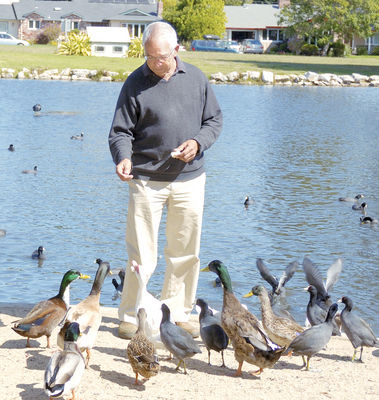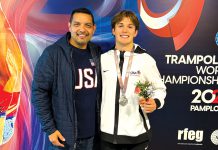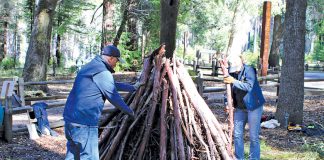
Although many of us have shared a nature walk together this year, I am sometimes uncomfortable with the term “nature walk.” To really behold nature, one must sit quietly, still the mind, and listen and wait. Then, nature will reveal its humorous and tragic life to you.
Inside my computer armoire, I have tacked a picture of one my environmental heroes, Rachel Carson, author of “Silent Spring,” as she sits on the side of a river not unlike our San Lorenzo. She looks up through the overhanging trees, poised with her binoculars, with a look of beatitude.
The Encarta Dictionary defines “beatitude” as the perfect happiness and inner peace supposed to be enjoyed by the soul in heaven.
I cannot promise you that on our next nature excursion, but, unlike our other events, we will spend much of our time sitting pondside at Quail Hollow Ranch. Thoreau thought of his ponds as “lakes of light” in “which the beholder measures the depth of his own nature.”
When humans first enter animal habitat, they produce what Todd Newberry — professor emeritus at University of California, Santa Cruz, and a bird-watching author and guide — calls “a wake of disturbance.” We will create “a wake of awareness” with our silence to invite the swallows and other birds back.
“Then, I think we see birds with new eyes and hear them with new ears,” he said. “We notice them. Proust reminds us that noticing is the subtlest of crafts, as when we notice the music inside the notes.”
Birding is more about listening than seeing. In fact, Newberry often takes a blind birder for walks. He can identify birds by their sounds, which Newberry thinks is the best way, because so many times, you can not see the bird, you can only hear it.
When the two were on an outing, Newberry began to describe the colors of a bird when he was interrupted by the blind birder.
“I can’t see colors — I can only see sounds,” the man reminded him.
Newberry explains that those who feel an emotional attachment to nature probably experienced a special moment — a moment when “lightning strikes.” For him, lightning struck for the first time when he was a lonely boy in boarding school and a meadowlark shot up from the ground at his feet.
He was lucky enough to be guided by a group of expert birders who mentored and nurtured his love of birds.
“Those kinds of experiences don’t seem to happen to young people now,” he said regretfully.
If Teddy Roosevelt had not had his lightning strike in the wild when he was young, would we have our national parks today?
When I was six, my family and I moved back to Texas from Minnesota. Until I was old enough to go to college, I was forced to live in a gray desert in western Texas. But I promised myself that one day, I would live again in the trees. My remembrance of trees was my lightning strike that resided in me until I left the big city and found the wild side of myself again in the Santa Cruz Mountains.
Take a child into the wild and let them experience their lightning strike before it’s too late.
If you are ready for a possible nature epiphany, join Newberry and me at Quail Hollow pond on Oct. 24. Space is very limited.
This free walk is the last of a series sponsored by the Valley Women’s Club Environmental Committee with a grant from the San Lorenzo Valley Water District. For information, please e-mail me.
• Carol Carson has been a docent for Henry Cowell Redwoods State Park and has taught courses on Big Basin State Park for UCSC Extension. She is an environmental educator, a member of the Valley Women’s Club’s Environmental and Educational Committees and can be contacted at ca****@*********on.com.










